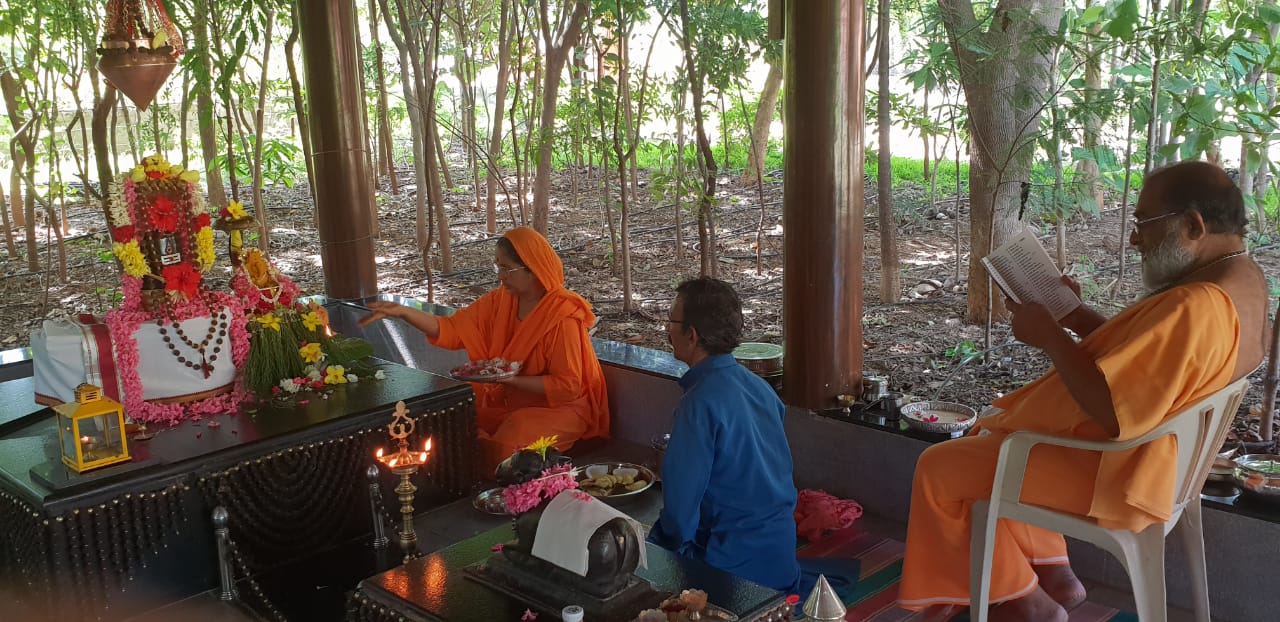Obstacles – consequences of karma
Lord Ganesha is known as Vighneśvara, an obstacle-giver. Do you think the Lord would ever be an obstacle-giver? Yes! He is an obstacle-giver. Why would He give obstacles?
It is like you are asking the fire: ”Why did you burn my hand? Why did you burn my finger?“ Te fire says: ”I did not burn your finger.“ ”But you did! Look at my finger! You burnt my finger!“ Te fire says: ”I would never do something like that to you or anyone. I did not burn your finger. Who asked you to put your finger into me? If you put your finger into me, your finger will be burnt. If you did not put your finger into me, it would not be burnt.“
Īśvara says: ”I am impartial to the results of your actions. But when you act against the law of karma (the law of the universe), your own actions burn you.“
Te Devatās are not doers, they do not do anything. Te Lord is not a doer. Īśvara is sākṣī, a witness. Te universe behaves in accordance with the cosmic laws. Īśvara is the lawgiver. He is a karma-phala-dātā, the giver of the results of one’s actions. He is a witness to all activity. He is not a doer. Lord Krishna says in the 4th chapter of the Gīta: ”O Arjuna! Tere is nothing I do.“
Tere is nothing to be done. What is human life? We think, that there is so much to be done. But there is nothing to be done. Te laws of the universe will work for all those, who are born into the universe. It all depends on how we use these laws:
If we create disharmony in our karma, in our doership, in our doinghood, then the results of our action is going to lead to disharmony. If I create obstacles for others, the result for me is also going to be obstacles. What I give out comes back to me. Te universe will only reflect, what I have given out to it and therefore – as a karma-phala-dātā, a lawgiver – the Lord is a giver of obstacles, vighnarājā. Te laws of the universe work accurately: If you do this, then that is the consequence. Who created this consequence for this doing? Te lawgiver did.
If I create obstacles for others, the result for me is also going to be obstacles. What I give out comes back to me.
He is the giver of the consequences of my karma. So is he really the giver of obstacles? Ask him. ”No“, He will say. ”I did not do anything. I am a witness to all karmas. I am not a doer. My svarūpa, my essence, is Universal Light. I don’t do anything. Te doer is the enjoyer.“ But you still say: ”No, no, clear my obstacles!“
Power of Prayer
Now you have a prārthanā, a prayer in you. You are performing another karma called prārthanā. For what? To remove the obstacle you created! I create my own obstacle and then I ask my obstacle to be removed. I walk barefooted, the thorn enters the sole of my feet and then I want somebody to remove the thorn.
To understand that I am the doer and the enjoyer of the action, imagine that I bit my tongue. ”Oww!“, I will say. ”What happened?“ ”I bit my tongue.“ ”Why would you do something like that? Why are you so hard on yourself?“ ”No, no, I’m not hard. My teeth bit my tongue.“ Here, I do not hold a grudge against the teeth. I tenderly protect the tongue which is bleeding, but do not knock off the teeth. Why? Because the teeth are mine and the tongue is also mine! I am the doer and the enjoyer of the action
Please understand: I am the kartā and I am the bhoktā. I am the doer, biting the tongue and I am the enjoyer of the bleeding tongue. Īśvara has no hand. He is a karmādhyakṣa, a witness, and a karma-phala-dātā and therefore I should recognize the obstacles, that I create in my own karmic unfolding of my life.
िवघहर: Vighnaharaḥ (Vighnahartā)
Vighnarājā becomes vighnahartā (one who takes away obstacles). Vighnakartā (obstacle giver) becomes vighnaharaḥ. And therefore Īśvara as karma-phala-dātā and karmādhyakṣa is your vighnahartā (obstacle remover). So when you are praying to Him, remember, that you are praying for removing the problems you have created!
I am the problem and therefore I am the solution. I’ve done a karma, that is incorrect and so I do another karma to neutralize the first one. It is how prārthanā intervenes. Prārthanā reduces the effect of my own karmic consequences and so, yes, the title is well-chosen:
He is the giver of obstacles and He is the remover of obstacles.
In fact, He is neither the giver nor the remover. From the next paradigm, from the higher paradigm, He is not even the giver.Vināyaka – Te karma sākṣī
Why did God create this blind child? Why did He create so much pain and suffering? It is human ignorance, the self-ignorance. Te human conditionality, living in the body-mind-complex, brings forth egos that create these afflictions for ourselves – not in one birth, but through multiple births. So is He a giver or a remover? He is neither the giver nor the remover. Te laws of karma play their līlā (the Divine play).
In fact, you are not even away from the Divine. If He is a sākṣī, a witness – then I am a sākṣī too. And hence I allow life to unfold, trusting whatever needs to be done in this karmic journey. I will learn my lessons and evolve with it into that Godhood – awaking to my Godhood, where doership and enjoyership become illusions.
Today, doership and enjoyership is my truth. I am a dreamer who believes, that the tiger is chasing me. Te Guru tries to tell me that: ”Hey, come on, this tiger can’t hurt you. You are the tiger.“ ”What? Te tiger is going to get me!“ Te Guru says: ”Relax.“ ”How can I relax? Te fear in me that I’m running for my life is real!“ Nobody can make a dream unreal, until I, the dreamer, wake up! Until he wakes up to the next reality, his dream is going to be the reality for him. And so too is doership and enjoyership.
Te ultimate reality
Duality is reality. When non-duality becomes my reality, duality becomes an illusion. When oneness becomes my reality then duality becomes an illusion.
मनोबुदहङार-िचतािन नाहं
न च शोतिजहेन च घाणनेते।
न च वोम-भूिमनरतेजो न वायुः
िचदाननरपः िशवोऽहम्िशवोऽहम्।।
na ca śrotrajihve na ca ghṛāṇanetre
na ca vyoma bhūmir na tejo na vāyuḥ
cidānandarūpaḥ śivo’haṃ śivo’haṃ.
I am not the buddhi (intelligence), I am not the manaḥ (mind), I am not the body, I am not those elements which bring the names, varieties and forms – the duality that I can see. Te truth is: Te whole image is my dream. Waking up to the truth is waking up to I as cit, in which I am neither a doer nor an enjoyer.
Te truth of Lord Ganesha is: he is paramajyoti. In Gaṇapati Atharvaśīṛṣa Upaniṣad, very beautifully, Lord Ganesha is described as paramajyoti, Infinite Light. He is not in this form. He is not a mere remover of your obstacles or a giver of obstacles. Tose are in the dream world, where we are. And hence, wherever we are – we are with this prayer:
”If I have created my obstacles – Lord, bless me, help me clear my obstacles!“








